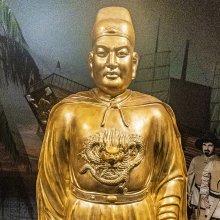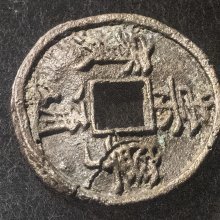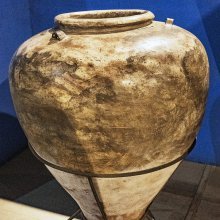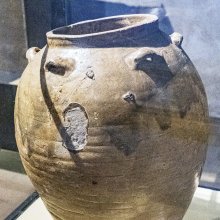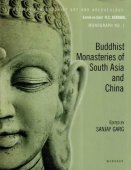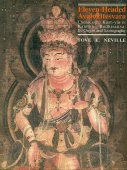China, Chīna, Chinā: 4 definitions
Introduction:
China means something in Buddhism, Pali, Jainism, Prakrit, biology. If you want to know the exact meaning, history, etymology or English translation of this term then check out the descriptions on this page. Add your comment or reference to a book if you want to contribute to this summary article.
Ambiguity: Although China has separate glossary definitions below, it also represents an alternative spelling of the word Cina. It further has the optional forms Chīna, Chīnā and Chīṇa.
Images (photo gallery)
(+125 more images available)
In Buddhism
Mahayana (major branch of Buddhism)
Source: archive.org: Bulletin of the French School of the Far East (volume 5)China [?] (in Chinese: Tchin-ts'ie) is the name of an ancient kingdom associated with Ārdrā or Ārdrānakṣatra, as mentioned in chapter 18 of the Candragarbha: the 55th section of the Mahāsaṃnipāta-sūtra, a large compilation of Sūtras (texts) in Mahāyāna Buddhism partly available in Sanskrit, Tibetan and Chinese.—Chapter 18 deals with geographical astrology and, in conversation with Brahmarāja and others, Buddha explains how he entrusts the Nakṣatras [e.g., Ārdrā] with a group of kingdoms [e.g., China] for the sake of protection and prosperity.

Mahayana (महायान, mahāyāna) is a major branch of Buddhism focusing on the path of a Bodhisattva (spiritual aspirants/ enlightened beings). Extant literature is vast and primarely composed in the Sanskrit language. There are many sūtras of which some of the earliest are the various Prajñāpāramitā sūtras.
Biology (plants and animals)
Source: Wisdom Library: Local Names of Plants and DrugsChina in the Hindi language is the name of a plant identified with Flemingia procumbens Roxb. from the Fabaceae (Pea) family having the following synonyms: Moghania procumbens. For the possible medicinal usage of china, you can check this page for potential sources and references, although be aware that any some or none of the side-effects may not be mentioned here, wether they be harmful or beneficial to health.
Source: Google Books: CRC World Dictionary (Regional names)1) China in Ghana is the name of a plant defined with Pennisetum pedicellatum in various botanical sources. This page contains potential references in Ayurveda, modern medicine, and other folk traditions or local practices It has the synonym Eriochaeta reversa Fig. & De Not. (among others).
2) China in India is also identified with Lagerstroemia indica It has the synonym Lagerstroemia indica var. alba Ram. Goyena (etc.).
3) China is also identified with Panicum miliaceum It has the synonym Milium esculentum Moench (etc.).
Example references for further research on medicinal uses or toxicity (see latin names for full list):
· Cytologia (1989)
· Biologia Plantarum (1994)
· Mémoires de la Société Botanique de France (1953)
· Synopsis Plantarum Glumacearum (1854)
· Revisio Generum Plantarum (1891)
· A Botanical Materia Medica (1812)
If you are looking for specific details regarding China, for example extract dosage, diet and recipes, health benefits, pregnancy safety, chemical composition, side effects, have a look at these references.

This sections includes definitions from the five kingdoms of living things: Animals, Plants, Fungi, Protists and Monera. It will include both the official binomial nomenclature (scientific names usually in Latin) as well as regional spellings and variants.
Languages of India and abroad
Prakrit-English dictionary
Source: DDSA: Paia-sadda-mahannavo; a comprehensive Prakrit Hindi dictionaryChīṇa (छीण) in the Prakrit language is related to the Sanskrit word: Kṣīṇa.
Prakrit is an ancient language closely associated with both Pali and Sanskrit. Jain literature is often composed in this language or sub-dialects, such as the Agamas and their commentaries which are written in Ardhamagadhi and Maharashtri Prakrit. The earliest extant texts can be dated to as early as the 4th century BCE although core portions might be older.
See also (Relevant definitions)
Starts with (+111): China bean, China berry, China cockle, China grass, China jute, China mandula maari, China pangpar, China pea, China pink, China root, China rose, China tree, China turpentine, China-alla, China-bilimara, China-dulogondi, China-po, China-rana-bheri, Chinaagoranta, Chinaar.
Ends with (+47): Adharachina, Akar bunga china, Alacchina, Anuchina, Apachina, Aprachina, Arachina, Arvachina, Arvvachina, Asamichina, Avachina, Batung-china, Bawang china, Bedara china, Bellichina, Bunga china, Capuchina, Chinachina, Chochina, Ciruela de la china.
Full-text (+563): Japa, Cinamshuka, Cina, Dvipakarpuraka, Vicitracinamshuka, Cinai, Dvipantaravaca, Barani, Mahacina, Odrapushpa, Odrakhya, Japakusuma, Kshina, Odra, Huna, Aparacina, Shuk-china, Java, China-alla, Cobacini.
Relevant text
Search found 146 books and stories containing China, Chīna, Chīnā, Chīṇa, Chinā; (plurals include: Chinas, Chīnas, Chīnās, Chīṇas, Chinās). You can also click to the full overview containing English textual excerpts. Below are direct links for the most relevant articles:
Historical Elements in the Matsya Purana (by Chaitali Kadia)
The River Gaṅgā or Ganges < [Chapter 4 - Geographical history in the Matsya-Purāṇa]
Historical Elements (3): Foreign Accounts < [Chapter 2 - History and Historical elements]
The Kailāsa Mountain < [Chapter 4 - Geographical history in the Matsya-Purāṇa]
The Vishnu Purana (by Horace Hayman Wilson)
Chapter III - Hymns of destroying the Nagas, origin of Sagara < [Book IV]
Topographical Lists from the Mahābhārata < [Book II]
Chapter III - Description of Bharata-varsha < [Book II]
Mahabharata (English) (by Kisari Mohan Ganguli)
Section LXXIV < [Bhagavat-Yana Parva]
Section LXV < [Rajadharmanusasana Parva]
Section CLXXVII < [Caitraratha Parva]
List of Mahabharata tribes (by Laxman Burdak)
International Affairs: A Survey < [October 1958]
The Continuing Crisis in Vietnam < [July 1965]
Nehru and China < [October 1987 – March 1989]
Lord Hayagriva in Sanskrit Literature (by Anindita Adhikari)
Hayagrīva in the Yoginī Tantra (Introduction) < [Chapter 6]
Hayagrīva in Buddhism < [Chapter 6]
Origin of Tantra < [Chapter 6]
Related products
(+8 more products available)

